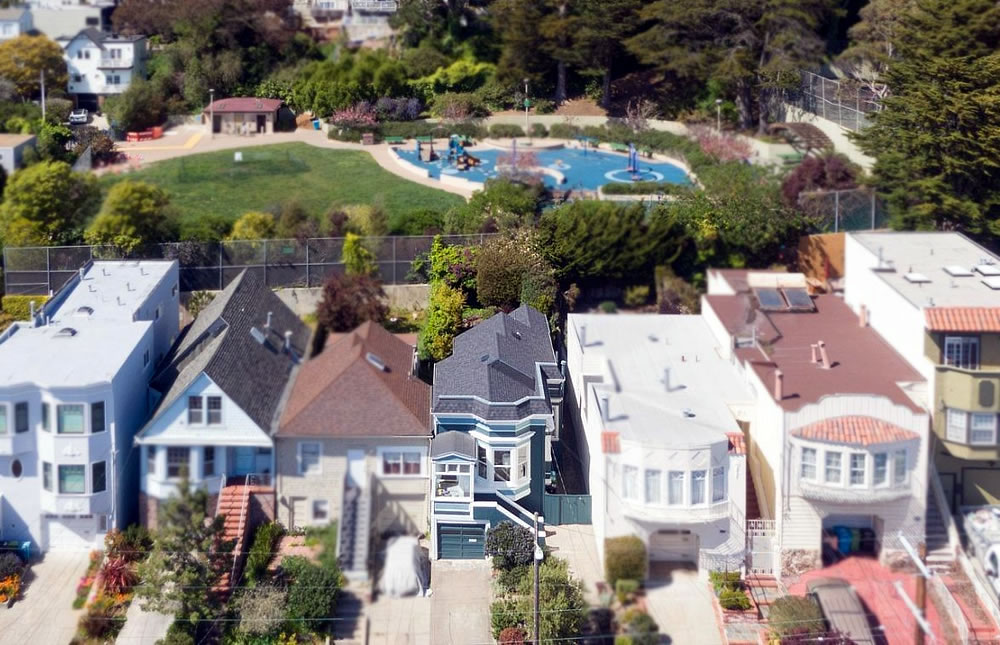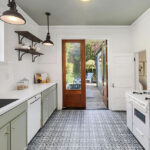As we outlined last month, the single-family starter home at 458 Mangels Avenue, “a charming Edwardian, nestled on a tranquil street in the Sunnyside Neighborhood” which had been purchased for $1.100 million in April of 2018, returned to the market priced at $1.299 million this past April, a sale at which would have represented net appreciation of just 18.1 percent, or a little over 3 percent per year, over the past 5 years.
Subsequently relisted for “$999,000” in July, the resale of 458 Mangels has now closed escrow with a contract price of $1.175 million, which is “nearly 18 percent over asking!” according to all industry stats, aggregate reports and perhaps a mailer or two, despite an original asking price and expectations which were 11 percent higher than sold.
And while the frequently misreported index for single-family home values in San Francisco is “still up over 30 percent!” from April of 2018, having dropped 11 percent over the past year, the resale of 458 Mangels represented net appreciation of just 6.8 percent over the past five years or roughly 1.2 percent per year on an apples-to-apples basis while the cost of debt has soared.









Is “Edwardian” really the best description for this ?? I’m assuming they derived this from the build date – 1909 – and in a way get points, since “Victorian” – which is often the default term for a vaguely Italianate (exterior) design such as this – would be technically incorrect. OTOH, the interior doesn’t seem very “Victorian” (in date) or “Italianate” (in form). Would transitional mean much ?? Durned architects…not following the rule book!!
This topic comes up here periodically. I don’t think that residential architects really care to be bound by any rule books, a lot of this stuff is subjective. You will hear them often say that a building should “be of its time.”
If the building has the features and proportions of a given style, then in my book that is the style of the building.
I’d go with Edwardian. It’s more the ceiling heights than the details that distinguish Victorian from Edwardian. Even modest Victorians have ceiling heights of eleven feet and it goes up from there. As a result, the double-hung windows are more vertical in proportion. Ceiling heights in Edwardians tend to max out at ten feet. The ceilings here look to be about nine feet.
Good point(s)!! I was thinking more of aesthetics – simple wainscotting and general absence of clutter – but why not consider functional aspects as well??
Of coure the two are inter-related; we probably tend to think that the tall ceiling heights drove the tall windows, but it was just as much the other way around: the need for light meant tall windows > tall floor heights (and tall everything else to maintain proportion.) But as technology changed, so did the design criteria. (Early Victorian=natural light/candles, Late V= gaslight, Edwardian=electric)
Do folks think actual real estate agents really advertise that the index for single-family home values in San Francisco is “still up over 30 percent!” over the past five years? I haven’t that stat anywhere other than on this site, and I get a lot of real estate-related mail in my (physical) mail box.
Speaking as a layman who certainly doesn’t “know the market” for SFH’s in Sunnyside, I don’t think that how that index or the market in general performed over the past five years matters as much as the market direction when bids for this home were submitted, especially in an era when there are multiple web-based valuation providers that can generate an estimate for any given home at the time it goes on market and make that valuation readily available to buyers and sellers alike.
I obviously wasn’t involved in this transaction, but it seems to me that potential buyers who bid on this house weren’t thinking as much about what happened since April of 2018 as they were conditions over the past year (i.e., the above-mentioned 11 percent drop) and few months. See also Recency bias. The market performance of the index over the past five years also doesn’t seem to me to be nearly as important as the fact that The Fed has raised the federal funds rate by 5 percentage points in the space of 14 months.
This house desperately needed the garage level, which I’m guessing has significant square footage and is underutilized, to be converted into bedroom space. It’s way, way too cramped on the main level. The problem is they already paid $1K/foot for it, so it would be a bit of an overpay when all is said and done (nevermind the headache of doing the work). This feels like it could have been a nice mini-flip for a certain type of buyer willing to do the work.
Do real estate agents really talk about “nearly 18 percent over asking”? Or is that a joke?
I realize they are merchants, but this is beyond stupid, especially if the last sold price is not revealed. How many potential buyers are taken in by this?
“Do real estate agents really talk about ‘nearly 18 percent over asking’”
No, unless you count “shouting it from every rooftop”, “sending out mailers to everyone in the neighborhood”, “repeating it loudly so that everyone overhears at random open houses”, “stopping random people on the street and telling them”, and “clipping said mailers to the collars of dogs tied up at grocery stores” as ‘talking’. The editor is ridiculous.
The housing market is so hot buyers are paying $1 million over asking price!
Or more recently and to the point, as prominently featured above the fold on CNN a few months ago: “When Minneapolis real estate agent Darisha Hill listed a three-bedroom, one-bath, 1924 bungalow on a Friday afternoon at the end of April, she scheduled open houses for both Saturday and Sunday to attract buyers. By Saturday evening the homeowners had received so many offers — a total of 25 bids, all of them over the $320,000 list price — that they canceled the second open house. Within 48 hours the sellers were in contract with a buyer offering well over the asking price.”
As a result, “Hill is sending out fliers telling other homeowners about it and reminding them that 24 unsuccessful buyers were prepared to pay over the asking price to live in their neighborhood. She ends with a call to action: Are you interested in selling your home?”
And while not reported nor revealed in the piece, but we tracked down, care to guess how the bungalow was priced relative to other recent sales in the neighborhood and how the “over asking!” price comp(ar)ed?
“Above the fold”?? I don’t think I’ve ever seen this phrase used outside the newpaper industry, where it’s literal meaning is apparent. Nonetheless. I guess the spirt can be carried over to the internet age where , presumably, it would refer to what appears on the first screen. Which seems kind of weird, here, since what I saw was: This house just got 25 offers. But, yes, the market is still cooling
I am always amazed (but more amused) by the attention payed, on this site and by the general public, to whether or not a property sells at, above, or below asking price, and by how much. It’s a COMPLETELY meaningless and artificial number and it amazes me that people attach any, let alone a lot of, importance to it.
Look, you can set a falsely-low asking price, generate a feeding frenzy, and sell way over asking. That’s what lots of agents do. I personally think it’s unethical to list a property at a price at which you wouldn’t accept a cash offer, but it happens every day. Naive buyers are apparently sucked in by this scheme even though it’s been going on as long as there’s been a real estate business.
Similarly, you can do your best to guesstimate actual market value, price there, and if you were right, you’ll sell around asking. You may not generate as much spurious interest because it won’t falsely appear to be some big bargain, but that’s all a psychological trick anyway.
Pricing too high happens sometimes too, and then you’re going to sell below asking, if you sell at all, because the quoted price may scare off some buyers who see it as unreasonable and as a statement of the seller’s expectations. I’m not an agent, but if I were, I’d never recommend to someone that the fish for the highest price in this way. I don’t think it works (and I doubt there are many agents who do either.)
In a hot market, like the one we had for years, people feel compelled to do irrational things to get an accepted offer and a lot of people overpay. There’s nothing inherently wrong with that so long as you recognize what you’re doing. But this idea that selling over asking price somehow, by itself, indicates a hot market, it’s just not true. I think you can sell properties over asking price in any kind of market. Just set the asking price lower! It’s truly meaningless. And, as SocketSite often points out, the “sold over asking!” pronouncement often comes after several reductions in the asking price.
In a market as large and diverse as ours, properties will almost always trade at their current market value. Sometimes it’s hard to know exactly what that is until you have a willing buyer and a willing seller. But the asking price is just a made-up number and I usually mostly ignore it and try to figure out what the property is actually worth.
But the asking price is just a made-up number and I usually mostly ignore it and try to figure out what the property is actually worth.
Gosh, it’s almost as if “attention payed, on this site” is for the very purpose of pointing this out.
I would be willing to go out on a limb and state that most buyers in S.F. don’t read this site and aren’t inured to real estate agent asking price legerdemain. I also think regular people (those not in the S.F. real estate “game”) trying to purchase a home for themselves are susceptible to “asking price” gamesmanship because they assume — however wrongly — that the asking price is the listing agent’s best estimate of what the property is worth. What it is actually worth is what a buyer is willing to pay, and that is also subject to gamesmanship, because if the buyer thinks that they’ll be outbid due to a hot market, they will increase their bid.
I would be interested in hearing how anyone can have an intellectually rigorous process for “figur[-ing] out what the property is actually worth” that isn’t a DCF analysis for the property in question. The problem for S.F. is that a large majority of properties sell for a price that is substantially over the price imputed by what the property would rent for on the open market, so you’re back to valuing the property at whatever a buyer is willing to pay.
You might think that the asking price is “truly meaningless”, but if the majority of people bidding against you accept it as a meaningful estimate of the property’s current market price, then you will get outbid and what you think about asking price won’t matter at all. That’s a corollary of how markets work.
With the rise of third-party valuation providers that make day-by-day valuations available over the web to anyone, hopefully this effect will be less salient in the near future. I’m not aware of any studies that have compared what they say a given home is worth at the time of closing and what it closes for, in aggregate (other than for Zillow), though.
For context, our reach has been running around a half million unique visitors (no, not simply “visits”) in a typical year, with an average of around 200,000 unique visitors in any given month (60 percent of which have been from San Francisco proper, the buying population of which is particularly plugged-in, followed by Oakland, New York, Los Angeles, San Jose, Palo Alto, San Rafael, Mountain View and Berkeley, at least in terms of domestic traffic in the absolute).
For additional context and those venturing out on limbs, there were fewer than 5,000 completed home sales in San Francisco over the past year.
And speaking of DCFs: Average Asking Rent in San Francisco Just Dropped YOY